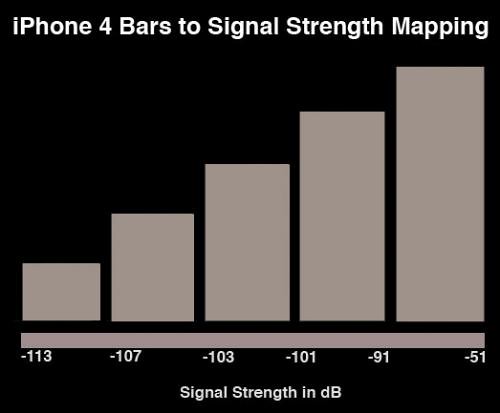Brian Klug and Anand Lal Shimpi of Anandtech have posted a thorough analysis of the the iPhone 4 antenna and how the device’s signal is affected when held in various positions. Setting up the testing environment, however, was a bit tricky since Apple removed the Field Test from the applications directory in the iPhone 4 filesystem.
Still, Klug and Shimi were able, after a bit of iPhone tomfoolery, to get a “numeric readout of signal strength on a non-jailbroken iPhone 4.” Here’s what they found.

To give you perspective, for a UMTS “3G” plant, -51 dBm is the best reported signal you can get – it’s quite literally standing next to, or under a block away from a tower. At the other extreme, -113 dBm is the worst possible signal you can have before disconnecting entirely. With a few exceptions, signal power as low as -107 dBm is actually perfectly fine for calls and data, and below that is where trouble usually starts. However, you can see just how little dynamic range iOS 4 has for reporting signal; over 40% of the range of possible signal levels (from -99 dBm to -51 dBm) is reported as 5 bars.
But onto the details that really matter – how exactly is signal strength affected by various phone holding positions:

As you can tell signal attenuation is most drastic when cupping the iPhone 4 tightly, and is even prominent when holding the device naturally. Meanwhile, the iPhone 3GS appears to be doing gangbusters. When placed inside a case, the iPhone 4 lags behind the 3GS, but provides greater signal consistency than the HTC Nexus One.
Still attenuation only tells part of the story, and overall, Klug and Shimi found that the iPhone 4’s antenna is, as is claimed by Apple, better than it was on previous iterations of the iPhone.
From my day of testing, I’ve determined that the iPhone 4 performs much better than the 3GS in situations where signal is very low, at -113 dBm (1 bar). Previously, dropping this low all but guaranteed that calls would drop, fail to be placed, and data would no longer be transacted at all. I can honestly say that I’ve never held onto so many calls and data simultaneously on 1 bar at -113 dBm as I have with the iPhone 4, so it’s readily apparent that the new baseband hardware is much more sensitive compared to what was in the 3GS. The difference is that reception is massively better on the iPhone 4 in actual use.
So while signal strength may vary wildly on the iPhone 4, it may in fact provide a greater voice calling experience overall than the 3GS.
It’s amazing really to experience the difference in sensitivity the iPhone 4 brings compared to the 3GS, and issues from holding the phone aside, reception is absolutely definitely improved. I felt like I was going places no iPhone had ever gone before. There’s no doubt in my mind this iPhone gets the best cellular reception yet, even though measured signal is lower than the 3GS.





Wed, Jun 30, 2010
News